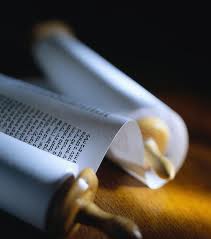 Torah is a Hebrew word that means “instruction” or “learning.” We understand the word Torah in two ways. In the narrow sense, Torah is the first five books of the Hebrew Bible. In the broad sense, Torah means all of Jewish learning — all of the accumulated Jewish wisdom of generations past, present, and future. In Jewish tradition, the study of Torah in any sense of the word is more than simply a nice thing to do. It is actually a commandment. And it is not just any commandment, it is the foundation for all other commandments.
Torah is a Hebrew word that means “instruction” or “learning.” We understand the word Torah in two ways. In the narrow sense, Torah is the first five books of the Hebrew Bible. In the broad sense, Torah means all of Jewish learning — all of the accumulated Jewish wisdom of generations past, present, and future. In Jewish tradition, the study of Torah in any sense of the word is more than simply a nice thing to do. It is actually a commandment. And it is not just any commandment, it is the foundation for all other commandments.
These are the things that produce fruits
for a person to enjoy in this world,
and which continue to yield bounty in the world to come:
Honoring one’s father and mother, acts of kindness,
and bringing peace between two people.
But the study of Torah is equal to all of them —
V’Talmud Torah k’neged kulam.
(Mishnah Peah 1: 1b)
Yes! Our very action-oriented tradition teaches that the study of Torah is equal to honoring one’s parents, doing acts of kindness, and bringing
about peace between people. Indeed some translations of this Mishnah suggest that the study of Torah is equal to all of these actions combined, while others understand it to mean that the study of Torah surpasses all of them combined. How do you interpret this text?
There re many excellent online resources for Torah study. Here are a few of our favorites:
The Written Torah – Torah Shebikhtav
 TANAKH
TANAKH
An acronym derived from three words:Torah, The Five Books of Moses; Nev’im, the writings of the 21 Prophets; Ketuvim, additional sacred writings. Together Torah,Nev’im and Ketuvim are known as the Written Torah.
TORAH
Bereshit ~ Genesis
Shemot ~ Exodus
Vayikra ~ Levitcus
Bamidbar ~ Numbers
Devarim ~ Deuteronomy
NEVI’IM—PROPHETS
Yehoshua (Joshua)
Shoftim (Judges)
Shmuel (I & II Samuel)
Melakhim (I & II Kings)
Yeshayah (Isaiah)
Yirmyah (Jeremiah)
Yechezqel (Ezekiel)
The Twelve (treated as one book)
– Hoshea (Hosea) – Yoel (Joel)
– Amos – Ovadyah (Obadiah)
– Yonah (Jonah) – Mikhah (Micah)
– Nachum – Chavaqquq (Habbakkuk)
– Tzefanyah (Zephaniah) – Chaggai
– Zekharyah (Zechariah) – Malakhi
KETHUVIM—WRITINGS
Tehillim (Psalms)
Mishlei (Proverbs)
Iyov (Job)
Shir Ha-Shirim (Song of Songs)
Rut (Ruth)
Eikhah (Lamentations)
Kohelet (Ecclesiastes)
Ester (Esther)
Daniel
Ezra/Nechemyah (a.k.a. Nehemiah)
Divrei Ha-Yamim (Chronicles)
THE ORAL TORAH—TORAH SHEB’AL PEH
An“unfolding,” over time, of the wisdom embedded in the Torah. Many believe that the Oral Torah was first spoken to Moses on Mount Sinai, then discussed, interpreted, and passed from generation to generation, each generation finding new meaning in it. In the 2d century CE, rabbis, fearing that the Oral Torah might be lost as Jews were becoming more geographically dispersed, began to write it down.The Talmud (Mishnah + Gemara),Midrash, codes and commentaries, right up to contemporary works of Jewish wisdom are known as the Oral Torah.
MISHNAH
The first printed version of the Oral Law. The Mishnah presents actual cases brought to rabbis between 70 and 200 CE by individuals who wanted to know how to apply Torah laws to situations in their everyday lives. In the Mishnah, the rabbis consider these cases, and o”er opinions based on their interpretation of Torah law.
GEMARA
Commentary on the Mishnah, developed between 350 and 500 CE.
TALMUD= Mishnah + Gemara.Written in Aramaic; Comprised of 63 Volumes
PIRKEI AVOT
A section of the Mishnah filled with rabbinic maxims and instruction on living a good Jewish life
RESPONSA
Rabbinic opinions that make Jewish life relevant to modern life by applying ancient principles to contemporary situations
HALACHAH
Jewish law
MIDRASH
Jewish legends.Written at about the same time as the Talmud, Midrash contains parables and other stories created to deepen understanding of the Torah narrative.ther stories created to deepen understanding of the Torah narrative.



